Clean, Drain, Dry… In every waterbody, every time.
Preventing the spread of aquatic invasive species starts with you. A cooperative effort is necessary by all persons and agencies involved with recreational activities to achieve the best results and protect our aquatic resources and recreational opportunities.
The general Clean Drain Dry procedure is described below; however, keep scrolling down the page for information pertaining to specific recreational activities. 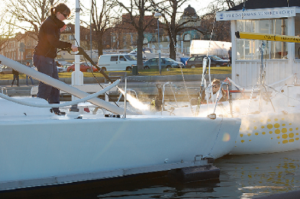
CLEAN off visible aquatic plants, animals, and mud from all equipment before leaving water access
DRAIN motor, bilge, livewell, and other water containing devices before leaving water access.
DRY everything for at least five days OR wipe with a towel before reuse.
For ANGLERS, the additional step of DISPOSE is recommended:
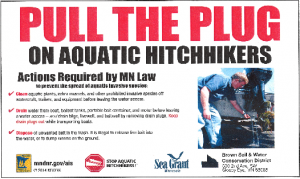
DISPOSE of unwanted bait, worms, and fish parts in the trash. When keeping live bait, drain bait container and replace with spring or dechlorinated tap water. Never dump live fish or other organisms from one water body into another.
Together the three steps of Clean Drain Dry greatly minimizes the risk of spreading Aquatic Hitchhikers into new locations.
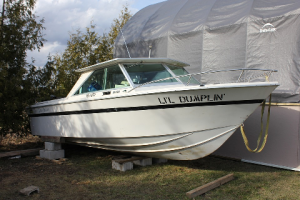
A note about chemicals. The use of chemical prophylactics or disinfectants (e.g., bleach) are not recommended for treating watercraft and recreational equipment. Chemicals may:
Report new sightings. If you think you have found an invasive species, note its exact location and, if possible, take a photo. Report new sightings to the appropriate authorities or use the USGS Sighting Report Form.
Know the rules! Specimens are needed to confirm sightings, but some jurisdictions prohibit possession and transport of invasive aquatic plants and animals. Before collecting specimens, contact your local natural resource management agency for instructions. Unauthorized introduction of plants, fish, or invertebrates into the wild is illegal in most states. Protect your property and our waters.
CLEAN off plants, animals, and mud from gear and equipment including waders, footwear, ropes, anchors, bait traps, dip nets, downrigger cables, fishing lines, and field gear before leaving water access. Scrub off any visible material on footwear with a stiff brush.
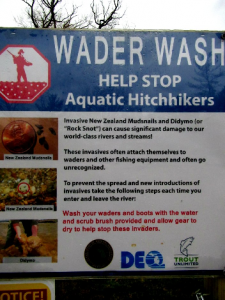
DRAIN water from watercraft, motor, bilge, bladder tanks, livewell and portable bait containers before leaving water access. Replace with spring or dechlorinated tap water when keeping live bait before leaving water access.
DRY everything five days or more, unless otherwise required by local or state laws, when moving between waters to kill small species not easily seen OR wipe with a towel before reuse.
DISPOSE of unwanted bait, fish parts, and packing materials, in the trash; do not dump them in the water or on land.
Other key actions:
CLEAN off visible aquatic plants, animals, and mud from watercraft, motor, trailer, and equipment before leaving water access. Scrub hull using a stiff brush. Rinse watercraft, trailer, and equipment with high pressure hot water when possible. Flush motor according to owner’s manual.
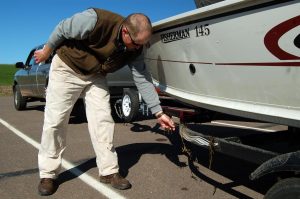
DRAIN water from watercraft, motor, bilge, bladder tanks, livewell, and portable bait containers before leaving water access.
DRY everything for five days or more, unless otherwise required by local or state laws, when moving between waters to kill small species not easily seen OR wipe with a towel before reuse.
For canoes, boards, rafts, kayaks, rowboats, paddleboats, inflatables, sculls, and other non-motorized recreational watercraft:
CLEAN off visible aquatic plants, animals, and mud from watercraft, gear, paddles, floats, ropes, anchors, dip nets, and trailer before leaving water access. Scrub hull using a stiff brush. Rinse watercraft, trailer and equipment with high pressure hot water, when possible. 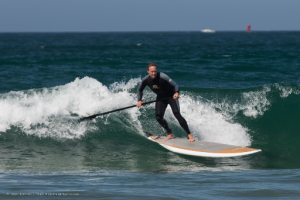
DRAIN water from watercraft, sponges, bailers, and water containing devices before leaving water access.
DRY everything five days or more, unless otherwise required by local or state laws, when moving between waters to kill small species not easily seen OR wipe with a towel before reuse.
CLEAN off visible plants, animals and mud from wetsuit, dry suit, mask, snorkel, fins, buoyancy compensator (BC), regulator, cylinder, weight belt, watercraft, motor, and trailer before leaving water access. Soak gear used in saltwater dives in 5% dishwashing liquid solution (1 cup/gallon), or gear used in freshwater dives in 3.5% salt solution, (½ cup/gallon) for 30 minutes. Rinse inside and outside of gear with hot water, when possible. 
DRAIN water from BC, regulator, cylinder boot, watercraft, motor, and any water containing devices before leaving water access.
DRY everything five days or more, unless otherwise required by local or state laws, when moving between waters to kill small species not easily seen OR wipe with a towel before reuse.
CLEAN off visible aquatic plants, animals, and mud from pontoons, cross members, steps, transom, rudders, chine, wheel wells, mooring ropes, wires, and cables. Scrub off any floats with a stiff brush. Rinse landing gear with high-pressure hot water, when possible. Landing in marine waters, if moving between freshwater bodies, can be an effective method of killing freshwater aquatic invasive species. 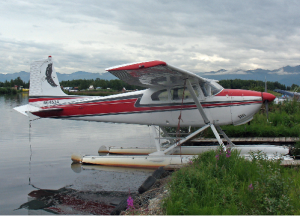
At water take-off:
After water take-off:
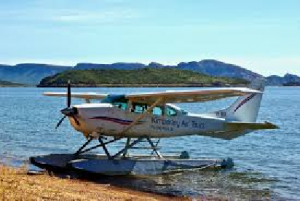
DRY water from floats before take-off.
DRY everything five days or more, unless otherwise required by local or state laws, when moving between waters to kill small species not easily seen OR wipe with a towel before reuse. Store aircraft on land when possible. Hot summer temperatures and flights during dry weather will help kill aquatic invasive plants and animals that may be on floats.
CLEAN off visible plants, animals and mud from waders, hip boots, watercraft, motor, trailer, ATV’s, push poles, decoys, decoy lines and anchors before leaving area. Brush hunting dogs and rinse kennels with tap water. 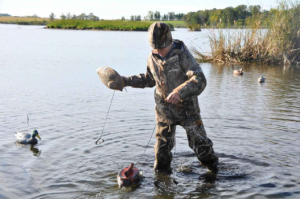
DRAIN water from watercraft, motor, bilge and other water containing devices before leaving water access.
DRY everything five days or more, unless otherwise required by local or state laws, OR wipe with a towel before reuse.
Other key actions:
CLEAN off visible plants, animals and mud from swimsuits, masks, goggles, floats, and beach toys. 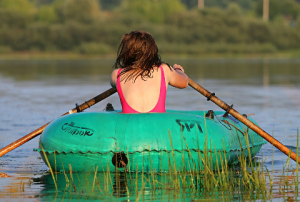
DRAIN water from toys or other water-containing devices before leaving water access.
DRY everything five days or more, OR wipe with a towel before reuse.
Aquarium and Pet Owners:
Many people think their fish, reptiles, or other aquatic species will survive if they turn them loose in local water. Unfortunately, many of these species do survive, reproduce, and become invasive. As an alternative to release, find another owner, donate to a pet shop or humane center, or humanely euthanize. In addition, never empty water from your fish tank into a water body or storm drain; instead pour water into the toilet or onto land far away from bodies of water.

Bait Harvesters:
In addition to the bait itself being potentially invasive, other, potentially invasive, species can be collected with baitfish. If moved, they can negatively affect waterbodies. Use these measures to reduce the risk of transporting aquatic invasive species.:
Tourists:
Individuals travel to other states and countries around the world. If you have entered the water in your travels, be sure to clean anything that came in contact with that water including shoes, boots, waders, boats, and trailers. You do not want to be responsible for bringing something that may be destructive into your home area. Also make sure you clean your items before leaving on a trip so that you do not inadvertently introduce an invasive species to the area you plan to visit.
Each of us can do our part to tell others.
Individuals: Inform friends and family about the threat of aquatic invasive species and how to use the Clean Drain Dry procedure to prevent their spread. Share this website and the Stop Aquatic Hitchhikers! Campaign materials with others. 
Media: The Media is an important resource to inform recreational users about the threat of aquatic invasive species and what these outdoor enthusiasts can do to protect our water resources. If you need additional information, Contact Us to help put you in contact with sources to interview.
Tour and Charter Boats Operators: Inform recreationalists about the status of the lake you are visiting. Discuss any aquatic invasive species present in the waterbody and the impact that has resulted. If the area you are visiting has not been impacted, encourage visitors to keep it that way. Provide Stop Aquatic Hitchhikers! materials and encourage customers to follow the Clean Drain Dry procedures every time they visit a body of water.
Clubs and Organizations: Use your newsletters or website to inform others about the aquatic invasive species, be sure to provide information about the Stop Aquatic Hitchhikers! campaign and link to this website. Awareness Weeks or exhibits at sporting events, boat shows, and other events can be also be used to inform others, demonstrate the principles of Clean Drain Dry, and distribute Stop Aquatic Hitchhikers! Materials. Check with your state fish and wildlife agency for training that might be available on how to educate others on aquatic invasive species.
